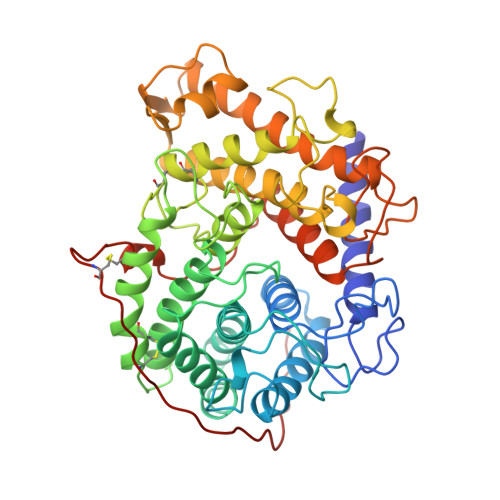Crystallographic complexes of glucoamylase with maltooligosaccharide analogs: relationship of stereochemical distortions at the nonreducing end to the catalytic mechanism.
Aleshin, A.E., Stoffer, B., Firsov, L.M., Svensson, B., Honzatko, R.B.(1996) Biochemistry 35: 8319-8328
- PubMed: 8679589
- DOI: https://doi.org/10.1021/bi960321g
- Primary Citation of Related Structures:
1GAH, 1GAI - PubMed Abstract:
Crystal structures at pH 4 of complexes of glucoamylase from Aspergillus awamori var. X100 with the pseudotetrasaccharides D-gluco-dihydroacarbose and acarbose have been refined to R-factors of 0.147 and 0.131 against data to 1.7- and 2.0-A resolution, respectively. The two inhibitors bind in nearly identical manners, each exhibiting a dual binding mode with respect to the location of the last sugar residues. The reduced affinity of D-gluco-dihydroacarbose (K1 = 10(-8) M) relative to acarbose (K1 = 10(-12) M) may stem in part from the weakening of hydrogen bonds of the catalytic water (Wat 500) to the enzyme. Steric contacts between the nonreducing end of D-gluco-dihydroacarbose and the catalytic water perturb Wat 500 from its site of optimal hydrogen bonding to the active site. Interactions within the active site displace the 6-hydroxymethyl group of the nonreducing end of both acarbose and D-gluco-dihydroacarbose toward a more axial position. In the case of D-gluco-dihydroacarbose the shift in the position of the 6-hydroxymethyl group occurs with a 12 degrees change in two dihedral angles of the glucopyranose ring toward a half-chair conformation. The observed conformational distortion of the first residue of D-gluco-dihydroacarbose is consistent with the generation of a glucopyranosyl cation in the transition state. Comparable distortions of stereochemistry in model compounds require approximately 2 kcal/mol, not more than 25% of the energy necessary to form the half-chair conformation in glucose. The magnitude of stereochemical distortion observed in the active site of glucoamylase suggests that favorable electrostatic interactions between the putative glucopyranosyl cation intermediate and the active site must be more important in stabilizing the transition state than mechanical distortion of the substrate.
- Department of Biochemistry and Biophysics, Iowa State University, Ames, 50011, USA.
Organizational Affiliation:




















